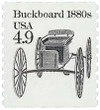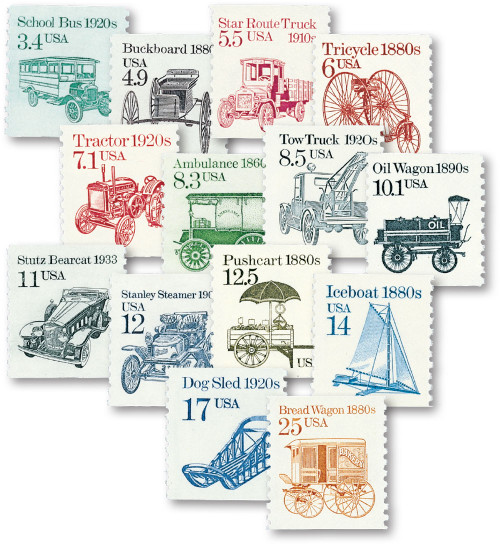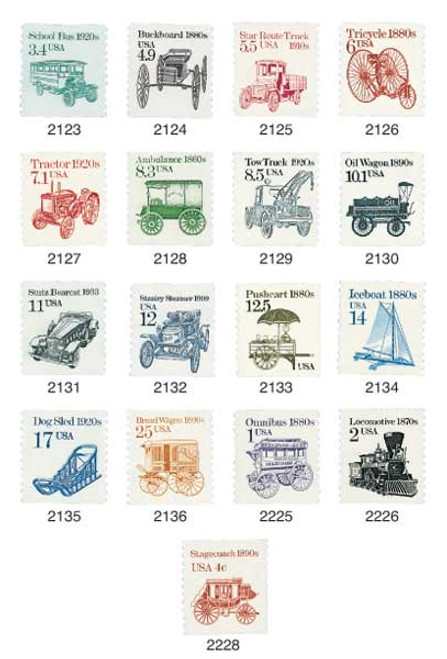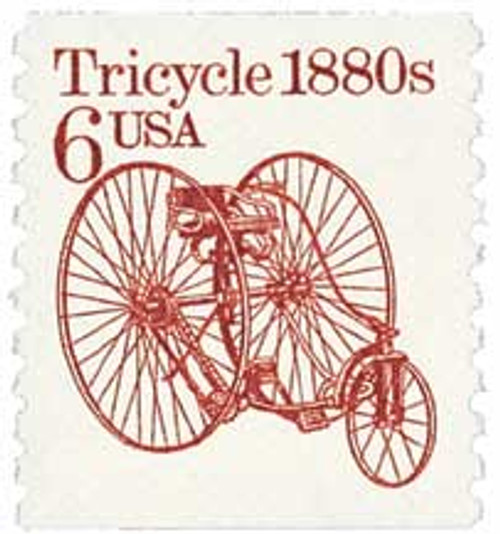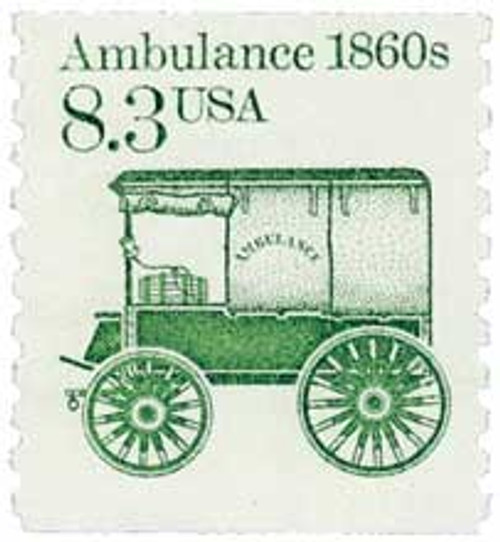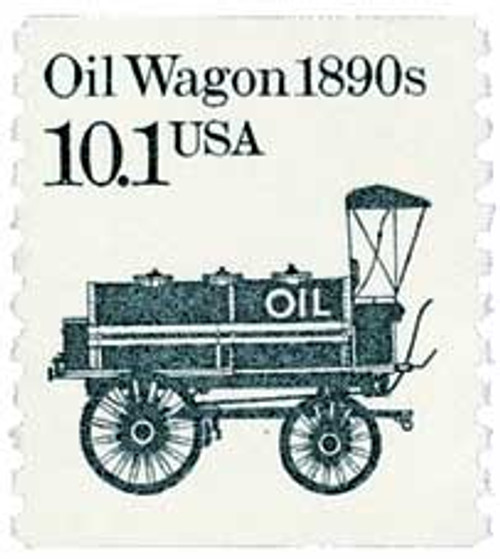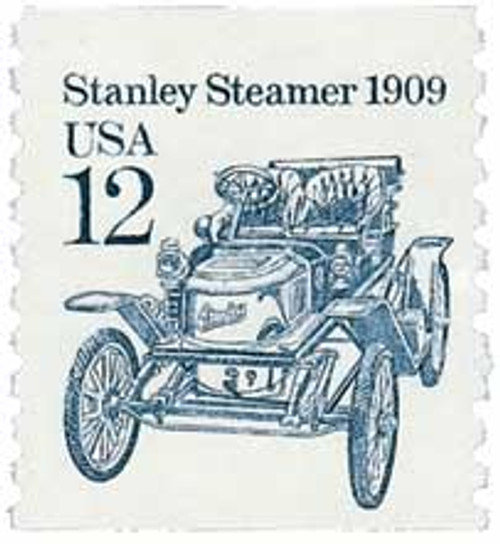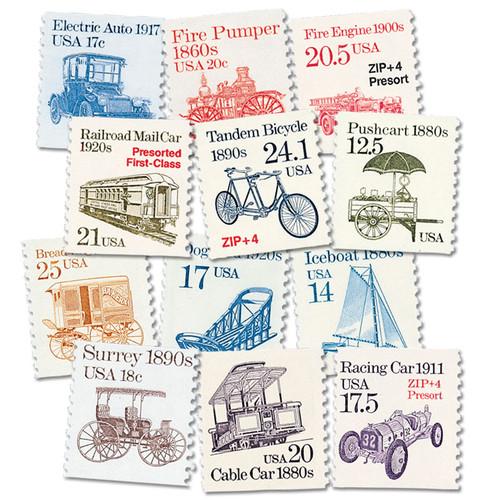
# 2124 - 1985 4.9c Transportation Series: Buckboard, 1880s
U.S. #2124
1985 4.9¢ Buckboard, 1880s
Transportation Series
- First stamp ever issued for this rate
- Third stamp of the year issued for use on nonprofit third-class mail
Stamp Category: Definitive
Series: Transportation
Value: 4.9¢; covered nonprofit third-class rate for mailings presorted with complete five-digit ZIP codes
First Day of Issue: June 21, 1985
First Day City: Reno, Nevada
Quantity Issued: 19,100,000
Printed by: Bureau of Engraving and Printing
Printing Method: Engraved
Format: Coils of 500 and 3,000, printed in 432-stamp plates
Perforations: 10 Vertically
Color: Brown black
Why the stamp was issued: This stamp was issued with a similar purpose to the 6¢ Tricycle and 3.4¢ School Bus stamps – each were used on nonprofit third-class mail. The 6¢ stamp handled the rate for mail sorted to within the first three digits of the zip code. The 3.4¢ stamp was for mail sorted and packaged according to carrier route. This 4.9¢ stamp covered the rate in between the other two – it was for nonprofit mailings presorted with complete five-digit ZIP Codes.
About the stamp design: This was the third US stamp design for William Bond. He built a scale model of a buckboard and used the scratch-board method to produce his artwork. He covered a whiteboard with brown ink and then scratched through the ink to create a line drawing.
Special design details: The 4.9¢ Buckboard stamp was available with and without a precancel. #2124 has no precancel, while #2124a has a precancel. Precancels are stamps canceled before being sold, to make mailing faster and cheaper for customers with large amounts of mail. Bulk mailers use precancels, then pre-sort their mail and save money. The USPS makes these stamps available with and without precancels for two reasons. One reason is to create another variety for stamp collectors. The other, is so the stamps can be used as add-on postage for packages slightly overweight.
First Day City: This stamp’s First Day ceremony was held at the NEVPEX-TOPEX all-topical exhibition in Reno, Nevada.
Unusual fact about this stamp: A major cracked plate variety exists in all stamps with plate number 4. An extra line resembling a buggy ship can be seen near the top left of the vehicle.
About the Transportation Series: On May 18, 1981, the USPS issued the first stamp in the Transportation Series, US #1907, picturing the Surrey, a doorless four-wheeled carriage. For the first time in US history, a coil stamp featured its own unique design rather than simply copying that of the current definitive stamp. Over 50 more coil stamps would be issued over the course of the next 15 years, each picturing a different mode of transportation. All of these types of transportation were used since American independence.
The various denominations provided face values to exactly match the rates for several categories of Third-Class mail (bulk rate and quantity-discounted mail). As the rates changed, new stamps with new values were added. Never before had a stamp series included so many fractional cent values.
The Bureau of Engraving and Printing printed most of the stamps in the Transportation Series, although private contractors printed a few. All but a few of the later stamps were produced by engraved intaglio. Differences in precancels, tagging, paper and gum provide a large number of varieties.
Scott Catalog separates the Transportation stamps into four groups. The stamps in the first group (#1897-1908) generally have the denomination in small type with a “c” next to it. These stamps were printed on the Cottrell rotary press, which joined together two plates to make a sleeve. The gaps between these plates created depressions where ink would collect and create joint lines on the stamps. Later issues were printed on a different press and didn’t have these joint lines.
The second group (#2123-36) had larger numbers with no “c.” The third group (#2252-66) was similar in appearance to the second group, but service inscriptions were added to the designs. These stamps also used a variety of paper and gum as well as different types of tagging. The fourth group (#2451-68) marked the end of fractional values. Now bulk mailers would use either the 5¢ or 10¢ stamp and then pay the difference from the actual postage rate.
The last stamp in the Transportation Series, the 20¢ Cog Railway, was issued on June 9, 1995, at the TEXPEX ’95 stamp show in Dallas, Texas. This marked the end of the largest US definitive series up to that time. Three new series would eventually replace it – American Transportation, American Culture, and American Scenes. Additionally, the Great Americans would go on to become the largest American definitive series.
History the stamp represents: Used during the late nineteenth century, this flat-bottomed carriage gave its passengers a bumpy ride. Rather than using metal cross-springs, an axle of flexible wood was used. A board in the front served as a footrest and prevented the drive from getting hurt if the horse bucked. These wagons, either manufactured or homemade, were generally driven in rural areas.
U.S. #2124
1985 4.9¢ Buckboard, 1880s
Transportation Series
- First stamp ever issued for this rate
- Third stamp of the year issued for use on nonprofit third-class mail
Stamp Category: Definitive
Series: Transportation
Value: 4.9¢; covered nonprofit third-class rate for mailings presorted with complete five-digit ZIP codes
First Day of Issue: June 21, 1985
First Day City: Reno, Nevada
Quantity Issued: 19,100,000
Printed by: Bureau of Engraving and Printing
Printing Method: Engraved
Format: Coils of 500 and 3,000, printed in 432-stamp plates
Perforations: 10 Vertically
Color: Brown black
Why the stamp was issued: This stamp was issued with a similar purpose to the 6¢ Tricycle and 3.4¢ School Bus stamps – each were used on nonprofit third-class mail. The 6¢ stamp handled the rate for mail sorted to within the first three digits of the zip code. The 3.4¢ stamp was for mail sorted and packaged according to carrier route. This 4.9¢ stamp covered the rate in between the other two – it was for nonprofit mailings presorted with complete five-digit ZIP Codes.
About the stamp design: This was the third US stamp design for William Bond. He built a scale model of a buckboard and used the scratch-board method to produce his artwork. He covered a whiteboard with brown ink and then scratched through the ink to create a line drawing.
Special design details: The 4.9¢ Buckboard stamp was available with and without a precancel. #2124 has no precancel, while #2124a has a precancel. Precancels are stamps canceled before being sold, to make mailing faster and cheaper for customers with large amounts of mail. Bulk mailers use precancels, then pre-sort their mail and save money. The USPS makes these stamps available with and without precancels for two reasons. One reason is to create another variety for stamp collectors. The other, is so the stamps can be used as add-on postage for packages slightly overweight.
First Day City: This stamp’s First Day ceremony was held at the NEVPEX-TOPEX all-topical exhibition in Reno, Nevada.
Unusual fact about this stamp: A major cracked plate variety exists in all stamps with plate number 4. An extra line resembling a buggy ship can be seen near the top left of the vehicle.
About the Transportation Series: On May 18, 1981, the USPS issued the first stamp in the Transportation Series, US #1907, picturing the Surrey, a doorless four-wheeled carriage. For the first time in US history, a coil stamp featured its own unique design rather than simply copying that of the current definitive stamp. Over 50 more coil stamps would be issued over the course of the next 15 years, each picturing a different mode of transportation. All of these types of transportation were used since American independence.
The various denominations provided face values to exactly match the rates for several categories of Third-Class mail (bulk rate and quantity-discounted mail). As the rates changed, new stamps with new values were added. Never before had a stamp series included so many fractional cent values.
The Bureau of Engraving and Printing printed most of the stamps in the Transportation Series, although private contractors printed a few. All but a few of the later stamps were produced by engraved intaglio. Differences in precancels, tagging, paper and gum provide a large number of varieties.
Scott Catalog separates the Transportation stamps into four groups. The stamps in the first group (#1897-1908) generally have the denomination in small type with a “c” next to it. These stamps were printed on the Cottrell rotary press, which joined together two plates to make a sleeve. The gaps between these plates created depressions where ink would collect and create joint lines on the stamps. Later issues were printed on a different press and didn’t have these joint lines.
The second group (#2123-36) had larger numbers with no “c.” The third group (#2252-66) was similar in appearance to the second group, but service inscriptions were added to the designs. These stamps also used a variety of paper and gum as well as different types of tagging. The fourth group (#2451-68) marked the end of fractional values. Now bulk mailers would use either the 5¢ or 10¢ stamp and then pay the difference from the actual postage rate.
The last stamp in the Transportation Series, the 20¢ Cog Railway, was issued on June 9, 1995, at the TEXPEX ’95 stamp show in Dallas, Texas. This marked the end of the largest US definitive series up to that time. Three new series would eventually replace it – American Transportation, American Culture, and American Scenes. Additionally, the Great Americans would go on to become the largest American definitive series.
History the stamp represents: Used during the late nineteenth century, this flat-bottomed carriage gave its passengers a bumpy ride. Rather than using metal cross-springs, an axle of flexible wood was used. A board in the front served as a footrest and prevented the drive from getting hurt if the horse bucked. These wagons, either manufactured or homemade, were generally driven in rural areas.






